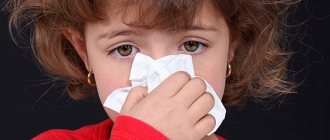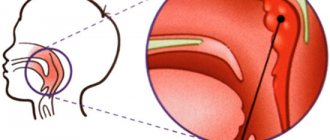Kalanchoe juice for runny noses for children: features of use
To properly treat a runny nose in children, it is necessary to provide them with high-quality care, as well as maintain optimal temperature and humidity in the room.
To make breathing easier, it is better to use proven folk remedies. This is especially important for young children, since any mother who cares about the health of her baby will always give preference to natural medicines. Kalanchoe will be an excellent remedy for a runny nose. Kalanchoe is a common plant found in many homes. Not everyone knows about its healing properties, so let's talk about them in more detail.
Where does Kalanchoe come from?
The ancestral home of Kalanchoe is considered to be Madagascar, the tropics of Africa, and the Cape Verde Islands. There, on wide slopes, the shores of seas and rivers, and arid, open terrain, you can really find Kalanchoe.
Kalanchoe is a typical tropical evergreen perennial plant of the extensive Crassulaceae family. Its genus includes about 200 species of various plants, which are characterized by various forms of shrubs with succulent leaves.
This perennial was first mentioned at the very beginning of the eighteenth century in notes on healing plants. There is an opinion that the first to bring Kalanchoe to our land were Russian traders, who witnessed the recovery of a Russian sailor from fever by chewing Kalanchoe leaves filled with juice.
In our area, the most common is Kalanchoe (biophyllum) Degremon, which has been used in everyday life for the treatment of many ailments for a long time.
Varieties of medicinal Kalanchoe
Kalanchoe grows under natural conditions in Asia, Africa, and America. The name of the flower has Chinese roots. The healing properties of the plant have been known for a long time, but our compatriots most often use Kalanchoe as an ordinary houseplant.
In the natural environment, you can find more than 200 varieties of this plant, but only a few species have amazing healing properties. In most cases, representatives of both folk and official medicine use pinnate Kalanchoe and Degremon species to treat people. For medicinal purposes, as a rule, the stem and leaves of the plant are used.
It is enough to place Kalanchoe in a pot, and the air in the entire room will be regularly purified - the flower has bactericidal properties. The plant works well in the fight against influenza and other infections, so there is no better remedy for treating colds. Anti-inflammatory, antibacterial and wound-healing properties have determined the use of Kalanchoe in the treatment of various injuries.
The plant does an excellent job of cleansing the blood and removing harmful substances from the body. The flower helps you easily wake up in the morning and gives a powerful charge of vigor and strength. Similar qualities can be felt if you stand near a Kalanchoe for just a few minutes.
Despite the huge number of positive properties, in most cases our compatriots use Kalanchoe to treat a runny nose.
Recommendations for the use of Kalanchoe for children
Many experts believe that during the first 3 days of illness, a runny nose in children should not be treated, since the body fights the disease on its own, and increased nasal flow is only one of the tools that helps in the fight against viruses. Each child reacts differently to the use of Kalanchoe. The plant really helps some people, but for others it can cause complications.
In order to identify possible negative consequences of using Kalanchoe juice, it is worth doing an allergy test. It is enough to apply a decoction or juice of the plant to the surface between the nose and upper lip. If no redness appears on the skin after 1-2 hours, then an allergy probably will not occur.
For the first time, you need to drop one drop of plant juice into each nostril. You can switch to the full dosage only if after the first use no negative effects appear in the form of redness of the skin or swelling. Remember that improper use of Kalanchoe can lead to serious complications even in adults, not to mention the children's body.
Adviсe
Before using Kalanchoe juice to treat rhinitis, check your baby’s reaction to this plant. Place one drop under the baby's nose above the upper lip and rub into the skin. After an hour, check the skin - if redness appears, you should stop using Kalanchoe. If the skin condition is normal, drop 1 drop of juice into each nostril of the baby and wait a little. If such actions do not lead to a worsening of the condition, you can continue to use Kalanchoe in the recommended dosages.
Instead of making your own Kalanchoe juice, you can use a ready-made pharmaceutical product, but pay attention to the composition. Do not give your child juice that has ethyl alcohol added to it. Homeopathic remedies are also not recommended, because there is very little Kalanchoe juice in such preparations.
the decoction of Kalanchoe has a milder effect After tearing off several leaves of the plant, pour 100 ml of water into them, bring to a boil and let it brew for a while. The cooled decoction is recommended for use before the age of 2 years. Although it has a less pronounced effect than juice, this remedy is safer.
How to prepare juice for instillation?
In order to cure a runny nose in a child, it is necessary to use juice or decoction prepared from Kalanchoe leaves. You can add other folk remedies to the drug, for example, onion juice, aloe.
Let's consider what the healing effect of Kalanchoe juice is. The product is designed to irritate the mucous membrane, as a result of which the patient begins to actively sneeze, thereby relieving the nasal passages of accumulated mucus. Because of this property, the plant is popularly called “sneezer”.
There are several factors to consider before starting treatment for your child:
- Kalanchoe juice should be used with caution so as not to damage the nasal mucosa;
- Fresh juice is best for use;
- The younger the child is, the less plant juice should be contained in the drops.
The youngest children are recommended to instill a decoction prepared from Kalanchoe leaves. The product turns out to be soft and quite safe. It is enough to drip the decoction into each nostril 2-3 times a day.
For older children, you can gently wipe each nostril with the juice of the plant. To do this, soak a cotton swab in the medicine and wipe the inside of the nose.
For children under one and a half years old, juice diluted with warm boiled water is suitable. Older kids are quite ready to use pure juice. In both cases, a few drops are used 3 times a day.
If you mix Kalanchoe juice with onion or aloe juice in a 1:1 concentration, you should also use the medicine 3 times a day.
When can a child have Kalanchoe?
The healing effect of Kalanchoe against a runny nose occurs due to the fact that the plant juice irritates the mucous membrane of the nasal passage. This leads to frequent and forceful sneezing. As a result, an adult or child suffering from a runny nose sneezes out the mucus that has accumulated in the nose. This method will help children who do not yet know how to blow their nose on their own.
Kalanchoe and its healing properties for a runny nose can cure rhinitis in 5-7 days. However, this treatment should be used extremely carefully for children under one year of age and only in a minimal dosage, since such a procedure is quite difficult to tolerate. In addition, instilling plant juice is not recommended for newborns and babies under three to five months. At this age, after putting Kalanchoe into the nose, active sneezing begins, as a result of which harmful microbes from the nasopharynx enter the ear, causing inflammation and otitis media in the infant.
Kalanchoe for runny nose is given to children after 6-12 months and only in diluted form. Moreover, it is better to use a diluted decoction rather than juice. And to speed up recovery, you can add liquid from aloe leaves or onion juice to the broth. In addition, you can buy a ready-made product based on Kalanchoe at the pharmacy, designed specifically for young children.
Avoid pharmaceutical drops that contain Kalanchoe, onions or aloe. Drops have a negative impact on the baby’s well-being and are not recommended until 2-3 years of age. To cure rhinitis in a child, choose gentle products designed specifically for children. Or prepare the drug at home. Next, we’ll look at how to make a decoction or weakly concentrated Kalanchoe juice for children with a runny nose.
Features of using Kalanchoe
Let's look at the most effective recipes with Kalanchoe juice, which are suitable for treating runny nose in children:
- Kalanchoe decoction is the mildest remedy, suitable for the smallest children. The smaller the child, the lower the concentration of plant juice in the decoction should be. To prepare, add a glass of water to a few leaves of the plant. Next, you need to put the water on the fire, turn it off after boiling and leave for a while.
- Kalanchoe juice can be obtained using several methods. The fleshy leaves are simply squeezed in your fingers. The dryish leaves are crushed, wrapped in gauze, and then squeezed out.
- A mixture of aloe and Kalanchoe juices is the most effective remedy used to treat runny nose in children. It is enough to mix 1-2 drops of juice from each plant for use.
In addition to instilling plant juice, you can treat a runny nose in another way. Pieces of cotton wool are soaked in a healing solution and then placed in the nasal passages. The last method is great for older children.
There are several restrictions for treating children:
- Kalanchoe should not be used at body temperatures above 37 degrees, as this is an indicator of the body’s active fight against the disease;
- allergic rhinitis cannot be treated with plant juices;
- the use of Kalanchoe for a runny nose in children is possible only for 5 days;
- redness, rash or other negative signs are a reason to stop using Kalanchoe.
The danger of a runny nose for infants
Due to the abundant secretion of snot, dust, liquid and mucus accumulate in the nasal passages of the baby, which leads to the formation of crusts. This causes severe discomfort and unpleasant sensations and makes breathing difficult. The child cannot eat normally and sleep peacefully, begins to get tired quickly and move slowly. Without proper treatment, a runny nose becomes chronic and causes serious complications.
Rhinitis in children leads to respiratory distress and difficulty. In addition, accumulated fluid and mucus can enter the middle ear cavity through the internal auditory tube, which causes otitis media. A runny nose provokes inflammatory processes in the nasal cavities, causing bronchitis, bronchial asthma and other serious diseases.
Prolonged and chronic runny nose causes changes in the chest and bones of the facial skeleton, disrupts the exchange of oxygen in the body, the functionality of blood vessels and the heart, and the respiratory system. The most common complications and diseases that occur after a runny nose:
- Bronchitis and bronchial asthma;
- Otitis;
- Laryngite;
- Pharyngitis;
- Sinusitis or inflammation of the sinuses.
To avoid such problems, it is important to carry out treatment in a timely and reliable manner. Children's rhinitis is cured not only by Kalanchoe or aloe, but also by other effective folk and pharmaceutical remedies, as well as proper care of the baby. For more information on how and how to treat a runny nose in a child, read the link https://vskormi.ru/children/nasmork-u-grudnichka-chto-delat/.
Traditional medicine has not been replaced by modern drugs offered by the pharmaceutical industry. Folk remedies and recipes help to effectively cure colds and eliminate nasal congestion. Kalanchoe is a versatile plant used in the treatment of many diseases.
Parents often use Kalanchoe for nasal congestion in a newborn. However, not all mothers trust such therapy; many prefer medications sold in pharmacies. The medical community has long proven the effectiveness of using this medicinal plant in the treatment of the common cold. Klanchoe is used both as a preventive measure and in particularly advanced cases, when even industrial drugs are powerless.
Data. The plant contains magnesium, copper, calcium, aluminum.
Negative reaction - what to do?
The beneficial properties of Kalanchoe cannot guarantee a complete cure for the runny nose, and the reaction to this remedy is individual. The use of medicines containing Kalanchoe should be agreed with a doctor.
Like any medicine, plant juice can cause a negative reaction:
- allergies or the appearance of secondary swelling of the mucous membrane;
- sneezing can lead to infection in the ear canals, resulting in otitis media;
- burns of the mucous membrane.
If you notice any negative symptoms in your child, you should immediately stop taking Kalanchoe and consult a doctor.
Author: Antonina Pyatnysheva, especially for Mama66.ru
Is it worth using Kalanchoe juice to treat runny nose in children?
A lot has been said and written about Kalanchoe in the nose. It is known that the juice from the fleshy leaves of this houseplant helps with a runny nose, but there is still debate about the use of such drops in children. Some say that this is an excellent remedy even for infants, others are sure that children should not drip Kalanchoe juice at all, since its benefit for rhinitis is only to eliminate symptoms, it does not cure, but its effect on children is truly unpredictable. Let's try to weigh the pros and cons.
Reviews
- Marina: “This is a proven remedy that my sister and I were also treated with. Now I use it on my family, we even have a special juice squeezer, I don’t remember when I bought it.”
- Alexander: “An unloved, but amazingly effective remedy. I remember how I was afraid of this procedure as a child, although it was very funny to sneeze afterwards. Now I rarely use it, somehow traditionally it’s easier to go to the pharmacy.”
- Ekaterina: “After numerous increases in prices for all pharmaceutical drugs, I gradually returned to traditional proven ones. Kalanchoe juice is an excellent remedy; it helps even with severe congestion. For children, it’s generally the best alternative, especially since it’s always at hand.”
Plant properties
Botanists include about two hundred different plants united by this species as Kalanchoe. In Russia, two grow on the windowsill and feel great - Kalanchoe Degremona and pinnate Kalanchoe. Therefore, when talking about the juice of this plant, we will mean both of these varieties of evergreen plants with succulent and fleshy leaves. Moreover, the differences between them are only external, and even then insignificant. Their basic properties are the same.
Kalanchoe juice has an antimicrobial effect, anti-inflammatory and hemostatic effect. It relieves swelling. When instilled into the nose it behaves as a local irritant.
You can see the recipe for using Kalanchoe for children with a runny nose in the following video.
Operating principle
You should not expect any miraculous therapeutic effect when treating a runny nose from Kalanchoe juice. It is practically non-existent, except for a small antimicrobial effect. But the local irritation that it causes after entering the nasal passages provokes a protective mechanism such as sneezing. The patient sneezes and coughs for a long time and persistently, due to which the mucus almost forcibly leaves the nose and nasopharynx, breathing is restored. True, only temporarily.
Is it possible for children?
In principle, it is possible. Some pediatricians even take it upon themselves to prescribe juice to their young patients, although they are well aware that the result is unpredictable and can unpleasantly surprise everyone.
Firstly, Kalanchoe juice can cause allergies in a child with a weakened immune system.
Secondly, it increases the risk of developing secondary edema and complications of rhinitis.
And as is clear from the principle of action, intense sneezing, although it helps to free the nasal cavity from snot, can cause injuries to the nasopharynx, and a child who is too young may even choke on mucus, since he does not know how to blow his nose.
That is why you can use Kalanchoe juice, but with extreme caution. Despite numerous reviews from mothers on the Internet, you should not risk using this product on infants and children under one year old. For older children, it is advisable to dilute the juice with water or saline solution, and also follow the dosage.
How to cook
If you have this unpretentious plant growing on your windowsill at home, there will be no problems with the raw materials for preparing the drug. Choose the juiciest leaf, cut it, squeeze it through cheesecloth. Dilute the juice with water (one to three) and drop it into each nasal passage. Some folk recipes recommend keeping the cut leaf in the refrigerator for several hours before squeezing.
If you don’t have Kalanchoe at home, you can buy a ready-made preparation at the pharmacy that contains such juice.
When choosing a pharmacy option, remember that children should not instill alcohol juice; products with the addition of ethyl alcohol are contraindicated in children.
Also, avoid homeopathic medicines that claim to contain this plant. There it, like all other components, is contained in such negligibly small microdoses that such treatment will definitely not be of any use.
Sometimes a decoction of the leaves of the plant is prepared for children; this is a milder remedy.
Instructions: use for children
Kalanchoe juice should be considered as an emergency measure for a child only if his nose is not breathing at all, and there is no way to blow his nose properly. This unconventional method of treating rhinitis should be abandoned if:
- If a child has an allergic runny nose. In this case, treatment of the cause is required, not elimination of the effect.
- If the child has a severe form of bacterial rhinitis. In this case, the mucus will have a green or gray color. This condition requires prompt treatment with antibiotics. Delay may cause complications.
- If a child has sinusitis with purulent nasal discharge.
- If the child has injuries to the nasal septum or curvature resulting from previous sinusitis.
Before first use, parents should conduct a home allergy test. To do this, apply a drop of concentrated (undiluted) juice to the child’s nasolabial triangle (in the dimple above the upper lip), rub lightly and evaluate the result after an hour and a half. If redness and swelling do not appear, Kalanchoe juice can be used. If even a minor reaction occurs, it is strictly forbidden to use this remedy for this child.
Contraindications
An unequivocal ban on the use of Kalanchoe juice is increased body temperature with a runny nose. If in a child it is above 37°, this indicates that nasal congestion and slight swelling are a clear sign that inflammation is taking place in the nasal passages. Not the worst, by the way, since it destroys pathogenic microorganisms.
If you use the anti-inflammatory agents of Kalanchoe juice at this stage, the inflammation will be “extinguished” too early, and the path for harmful microbes will be clear.
Thus, the juice of the plant should not be used at the beginning of the disease; it is better to use it at the end of the disease, when everything is over and all that remains is to get rid of excess mucus in the nose.
You should not drip Kalanchoe for too long, as this herbal remedy dries out the mucous membranes greatly. This can significantly complicate the treatment of rhinitis. Often, for children, the juice of another plant, aloe, is added to Kalanchoe juice; this makes such drops more gentle and reduces the likelihood of drying out the mucous membrane of the respiratory organs.
In any case, before using this herbal medicine to treat a child, you should consult your doctor. I repeat once again: Kalanchoe juice is not harmless and safe; independent experiments in this situation are inappropriate and even criminal.
You can see the recipe for drops for children with Kalanchoe based on saline solution in the following video.
medical reviewer, psychosomatics specialist, mother of 4 children
Age restrictions
When treating a runny nose, it is taken into account at what age you can drip Kalanchoe juice into a child’s nose. Despite its natural origin, the use of the juice of this plant in the treatment of children's runny nose has age restrictions. In connection with the use of Kalanchoe juice for runny noses in children of different ages, there are 2 points of view:
- Pediatricians do not recommend treating infants under one year of age with this remedy, since even weakly concentrated Kalanchoe juice can cause severe sneezing attacks in infants, during which bacteria enter the ear cavity from the nasopharynx. This is fraught with the development of a dangerous and difficult to cure ear disease - otitis.
- Most experts believe that treating a runny nose with Kalanchoe juice is not suitable for children under 3 years of age also due to the risk of developing otitis media and allergic reactions.
Thus, a child over 3 years old can drip Kalanchoe into the nose without any serious consequences. Whether to use medicine for a runny nose or not in each specific case is up to the child’s parents to decide together with the attending physician.
How does Kalanchoe work?
It contains flavonoids, tannins, enzymes, acids, as well as minerals and vitamins. Thanks to these components, Kalanchoe helps in the regeneration of the nasal mucosa, eliminates congestion, relieves inflammation, disinfects and cleanses the sinuses of accumulated mucus.
The remedy is also effective for a runny nose because it irritates the mucous membrane, and accordingly causes sneezing. The child begins to sneeze heavily, as a result of which the nasal passages are cleared. This is a good alternative to blowing your nose, as babies do not know how to do this. Recovery occurs in 5-7 days.
Kalanchoe is suitable for complete absence of nasal breathing or slight swelling.
Also, the juice of this plant has an immunomodulatory effect. It increases local immunity and thereby protects the child from respiratory diseases in the autumn-winter period.
Questions and answers
Where can you buy Kalanchoe juice?
This remedy is popular in the treatment of rhinitis, so drug manufacturers have long been producing products containing the extract of this medicinal plant. They can be purchased at the pharmacy. The plant itself is easy to grow at home. Using your own grown Kalanchoe, you will be confident in the naturalness of the ingredients.
Data. In 1966, laboratory studies confirmed the therapeutic effect of Kalanchoe Degremon. Scientific medicine uses it in the healing of ulcers, wounds, burns and purulent abscesses.
Is Kalanchoe really good for nasal congestion? Is it possible to drip Kalanchoe to a baby?
The plant is shown to both adults and even newborns. To do this, you need to squeeze the juice from the leaves, strain it and bury it in your nasal sinuses. When using Kalanchoe, mucus is released, which destroys pathogenic microflora. This method of treatment is suitable for adherents of everything natural, for those who are wary and wary of chemistry.
Data. When used externally, this plant has virtually no contraindications. Possible harm will occur if taken orally during pregnancy, allergies, tumors and blood clots.
Is any type of Kalanchoe suitable for eliminating the disease?
Kalanchoe pinnate and Degremon are most often used in folk and scientific medicine. Kalanchoe degremon is found on the windowsills of our compatriots much more often than the pinnate one. Finding this variety of plant should not be difficult.
The use of Degremon for colds and flu has only positive reviews, and it has been used for quite a long time. This specimen produces a large number of new leaves in a short period of time. The plant has a curved, low stem that needs some kind of support.
The second type is a perennial plant reaching 150 cm in height. In medicine, juice squeezed from freshly cut leaves is used. Before dripping feathery Kalanchoe, it should be thoroughly washed and stored in a dark place for at least a week. In this case, the temperature should be 25 °C. The leaves should be squeezed out and the resulting mixture should be strained, for example, through cheesecloth. Ethyl alcohol can be added to this solution, but not more than 20%. Cut leaves can be refrigerated for three days. Then Kalanchoe juice will become much more useful, because chemical processes will start in the plant, during which shoots begin to appear.
Data. The upper (aerial) part of the plant is used in the treatment of diseases.
In the autumn-winter period, mothers are especially puzzled by the choice of effective, fast-acting and natural remedies for the common cold. One of them is Kalanchoe. When using it, you should take into account the age of the child and follow the prescribed dosage.
Is it possible to drip Kalanchoe into the nose of children?
Since the plant juice is a natural remedy, it is safe even for infants. But before use, you need to test for an allergic reaction. A drop of juice should be applied to the area between the nose and upper lip. If there is no negative reaction within 1-1.5 hours, then the product is approved for use.
If you are in doubt at what age you can use Kalanchoe, consult your pediatrician. Although this plant is generally safe even for newborns, it should not be used before six months of age. Small children find it difficult to tolerate prolonged sneezing.
How to breed Kalanchoe
The juice of this plant cannot be used in its pure form for infants. It must be diluted with boiled water. Unboiled water should not be used, as it may contain pathogenic flora.
The smaller the child, the lower the concentration should be. It is recommended for infants to dilute juice with water in a ratio of 1:3; for children over 2 years old, the proportion can be 1:1. From 3 years old you can use undiluted juice.
Alcohol tincture of Kalanchoe cannot be used for instillation into a child’s nose.
To obtain the juice, you will need several leaves of a young plant. They need to be thoroughly washed, crushed, placed in gauze and squeezed. The resulting juice must be stored in the refrigerator for no more than 7 days.
The best products based on Kalanchoe
Based on Kalanchoe, you can prepare several types of medicines for runny nose in children. The most effective, easy to prepare and use:
- Kalanchoe juice;
- decoction of Kalanchoe;
- a mixture of Kalanchoe and aloe juices.
These forms of Kalanchoe-based medicines offer different dosages and treatments. Along with the listed remedies, pharmaceutical preparations with Kalanchoe for instillation into the nose are actively used in the fight against children's runny nose.
Plant juice
Kalanchoe juice is successfully used for illness. It is used as follows:
- From an adult plant (it is advisable not to water it for about 3 days before use), several lower leaves are broken off. For infants, the medicine is prepared from the top leaves.
- The raw materials are placed in the refrigerator for a couple of days.
- Leaves left in the refrigerator are crushed to a pulpy state.
- Through several layers of gauze, the juice is squeezed out of the crushed mass.
- Before instilling Kalanchoe into the nose of a baby, the resulting juice is diluted with clean water. Dosage – 1 drop in each nostril 2-3 times a day.
- Drops of Kalanchoe juice for older children are instilled into the nose, 2-3 drops several times a day without prior dilution with water. You can lubricate the nasal cavity with a cotton swab dipped in diluted juice.
Decoction
The body of infants up to one year old is sensitive to the active components of the herbal remedy. To avoid the appearance of an undesirable reaction of the baby’s body to concentrated Kalanchoe juice, it can be treated with a decoction of this plant.
Preparing a decoction of Kalanchoe is not difficult. Before use, the flower leaves are placed in the refrigerator for 3-5 days.
To treat babies up to one year old, the plant in the form of a decoction is used as follows:
- Several washed succulent leaves are poured with 200 ml of clean water. Bring to a boil over low heat.
- The product is infused for an hour.
- The finished medicine is filtered through several layers of gauze.
- A decoction of Kalanchoe obtained in this way is dropped into the child’s nose, 1 drop several times a day.
When treating infants, it is preferable to use young plants. They contain nutrients in lower concentrations than in mature flowers.
A mixture of Kalanchoe and aloe juices
Aloe has many medicinal properties. It can relieve inflammation and destroy bacteria, so it is used in the treatment of children's runny nose along with Kalanchoe.
To prepare a medicine based on these medicinal plants, Kalanchoe juice is prepared separately, aloe juice is obtained in the same way and the ingredients are mixed in equal proportions. For older children, the medicine can be dripped into the nose in its pure form, but for treating infants it is diluted with water (1 to 3).
Pharmaceutical preparations with Kalanchoe for instillation into the nose
In addition to self-prepared medicinal products from Kalanchoe, you can purchase affordable preparations based on it or ready-made juice in pharmacies. In most cases, such medications are available in the form of drops. In addition to being effective, they are very convenient to use.
How to drip plant juice
To help the child get rid of rhinitis, and not to harm, it is necessary to use the prepared drops correctly. You can instill up to 5 times a day, 1 drop in each nostril. If there are no negative reactions, then after 2 days the dosage can be increased to 2 drops.
Before each procedure, the nasal passages must be cleaned with saline solution. If the child knows how to blow his nose, then first you need to inject the solution and then ask him to blow his nose. A nasal aspirator should be used for infants.
If 3-4 days after the start of treatment the runny nose does not decrease, you should go to the hospital. The child may require more serious therapy.
Is it possible to use Kalanchoe to instill snot in an infant?
Kalanchoe is called indoor ginseng, the tree of life, “a surgeon without a knife.”
The range of healing effects of the plant is quite wide; adherents of traditional medicine drop Kalanchoe into the nose of a child for acute respiratory diseases, influenza, rhinitis, frontal sinusitis, and sinusitis.
The plant is poorly studied and is practically not used in traditional medicine. This is all due to the ambiguous reaction caused by plant components after using Kalanchoe juice.
Indoor ginseng for runny nose for children
What is a plant
Kalanchoe is a plant of the Crassulaceae family and belongs to the genus of succulents. More than 200 types of culture are found in nature, but 2 types of flowers are suitable for pediatric therapy: Cirrus and Degremona.
How to breed Kalanchoe
How to reduce a baby's temperature - reasons and methods
Before dripping Kalanchoe into a child’s nose, the concentrated juice of the flower is diluted with distilled water or olive oil in a 1:1 ratio.
How to properly put drops on a child's nose
Effective ways to relieve a child under one year old from nausea
There are 3 ways to prepare juice from indoor ginseng, taking into account the age of the child.
For children over 3 years old, drop 1 drop of diluted concentrated juice into the nasal passage, blow out the snot, and lubricate the skin with cream. A decoction of the leaves of the flower is effective in combating the runny nose.
One finely chopped leaf is enough for 1 liter of water. The contents should boil and cool. The filtered solution is dripped 2 drops into the nostril.
https://www.youtube.com/watch?v=hrLD4EWuTO8
For children 12 years old, it is advisable to instill multicomponent drops, enhancing the effect of the medicine. A high concentration of Kalanchoe juice can harm infants and people with highly sensitive mucous membranes. Before use, you should consult your doctor.
Treatment with plant extract of Kalanchoe baby
Which Kalanchoe is better to choose?
Flowers over 3 years old quickly and effectively fight colds and runny noses. The most valuable juice is obtained from the lower leaves of the plant, which are large in size and fleshy. You should not use wilted or diseased leaves; the juice will not be of the best quality.
Interesting. Kalanchoe juice for a runny nose is obtained from a plant 1-3 years old - young shoots and leaves of the crop contain a less saturated concentration of chemical elements.
How to prepare juice for instillation
The recipe for making healing drops from Kalanchoe juice is quite simple:
- After 7-10 days, stop watering the flower.
- Cut leaves and young stems are thoroughly washed and dried.
- The preparations are placed in the refrigerator for 10-14 days.
Important! It has been scientifically proven that with prolonged exposure to cold and the absence of ultraviolet radiation, the intensity of the production of biologically active components increases.
It is convenient to squeeze out the juice using a homemade garlic pressure device. The finished product is stored in the refrigerator. Otherwise, the juice quickly loses its healing properties.
Recipes for multi-component drops (for children over 10 years old)
It is allowed to add additional elements to the resulting Kalanchoe extract that enhance the effect of the medicine. The arsenal of folk healers is rich in many recipes:
- Kalanchoe, aloe. Fresh plant juice is mixed in a 1:1 ratio, and 3 drops of the product are dripped into the nose in the morning, afternoon, and evening. The shelf life of the drug in the refrigerator is maximum 1 day.
- Kalanchoe, onion. Onion, grated on a coarse grater, is squeezed out. Mix 1 teaspoon of the resulting juice with 3 teaspoons of Kalanchoe concentrate. The mixture is kept in the refrigerator for 1 day.
- Kalanchoe, lemon balm, St. John's wort. It is suggested to pour a glass of boiling water over 2 tablespoons of lemon balm and hold in a water bath for 15 minutes. In a similar way, you need to prepare a decoction of St. John's wort. The resulting liquid is filtered and mixed with Kalanchoe juice in equal parts.
Saline solution with Kalanchoe juice
Advice. To treat a runny nose with the extract of the tree of life, for children over 10 years old, cotton pads are soaked in a healing solution and placed in the nostrils. Before applying the drops, it is important to conduct a sensitivity test.
Recipes for babies
Infants are allowed Kalanchoe extract to treat a runny nose, provided that the juice is diluted with boiled water in a ratio of 1:3. It is also necessary to check the reaction of the mucous membrane, preventing negative consequences.
The juice of the flower is first applied to the skin between the nose and upper lip for 1-2 hours.
Whether it is possible to drip Kalanchoe to children under one year of age depends on the presence of an allergic reaction - if there is no itching or redness on the skin, the product is dripped into the child’s individual nostrils, 1 drop at a time.
Pharmaceutical product
Pharmacy concentrate is suitable for a runny nose in the form of nasal drops. The dosage is determined by the age of the child, the form of the disease and the duration of the pathology.
Pharmaceutical drug
There are restrictions for therapy for children:
- Before treating an infant with pharmaceutical Kalanchoe, the solution must be diluted.
- Kalanchoe juice is contraindicated at body temperatures above 37 degrees.
- Allergic rhinitis cannot be treated with herbal extracts.
- The maximum period for treating a runny nose with Kalanchoe concentrate is 5 days.
- Redness, rash, irritation in a newborn or older child are reasons to stop using the flower.
- After using Kalanchoe juice, the child will experience sneezing; it should not be debilitating. If the baby sneezes too often or chokes, it is necessary to reduce the concentration of juice and instill smaller proportions.
- Do not drip your nose before going to bed or eating. The child will begin to sneeze intensely. You will need several handkerchiefs.
- If children over 3 years old have a normal reaction to Kalanchoe, the medicine is suitable for prophylaxis (once a month or during a viral epidemic).
- If you have a runny nose, you need to regularly ventilate the room, ensure a comfortable microclimate, maintain optimal humidity in the room, give plenty of fluids, do not overcool, or overheat the patient.
Blowing a child's nose
Advice. Dr. Komarovsky does not recommend treating a runny nose during the first 3 days during ARVI. Mucus in the nose prevents the penetration of harmful microorganisms through the nasopharynx to the throat and lungs.











